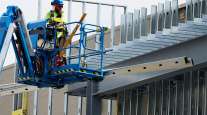First Quarter US Economic Growth Exceeds Previous Estimate

The world’s largest economy expanded more than previously projected in the first quarter as improved performance in trade and business investment more than made up for weaker consumer spending.
Gross domestic product, the value of all goods and services produced, rose at a 1.1% annualized rate, compared with a previously estimated gain of 0.8%, a Commerce Department report showed June 28 in Washington. Corporate profits at the start of the year were also revised up, giving a brighter picture to gross domestic income.
The economy shows signs of accelerating so far this quarter as the drivers of growth have switched, with consumer spending rebounding while business investment lags behind. While gains in employment and low borrowing costs are helping propel household demand, uncertainty in the wake of Britain’s vote to leave the European Union is a longer-term risk to already weak corporate outlays and exports.
“Consumer spending looks to be bouncing back fairly strongly,” said Ryan Sweet, a senior economist at Moody’s Analytics Inc. in West Chester, Pennsylvania, who correctly projected the gain in GDP. “The economy can weather the impact of Brexit.”
The median forecast of 71 economists surveyed by Bloomberg News called for a 1% rise in GDP. Estimates ranged from an increase of 0.8% to 1.2%.
The report marked the last of three readings for the quarter. The advance estimate of second-quarter GDP is scheduled for July 29, when annual revisions will also be issued.
The economy will expand at a 2.5% rate in the second quarter and average 1.9% for this year, according to the median projection in a Bloomberg survey conducted in early June.
Household consumption, which accounts for about 70% of the economy, grew at a 1.5% pace in the first quarter, the weakest in two years and down from a prior estimate of 1.9%. Reductions to outlays on transportation, financial and recreational services swamped a bigger gain in health care.
Offsetting the disappointing performance in consumer spending, the new figures showed the trade gap last quarter actually narrowed rather than widened as previously projected. Exports eked out a tiny gain, while imports declined more than last estimated.
Also contributing to the stronger growth in the first quarter was stronger business spending on intellectual property, which grew at a 4.4% annualized rate, compared with a prior estimate of a 0.1% drop. That included higher readings on outlays for computer software and research and development.
Corporate profits offered a better picture. Before-tax earnings rose 1.8% from the prior quarter compared with a previously reported 0.3% gain. Still, over the past year profits were down 4.3%.
The bigger gain in profits lifted total income in the economy, which combines all forms of earnings. GDI increased at a 2.9% annualized pace, the most since the third quarter of 2014, up from a previous estimate of 2.2% rate.
Theoretically, the income and GDP figures should match over time although they often diverge in the short term. The stronger performance by the earnings side of the ledger adds to signals that first-quarter GDP figures may have been underestimated.
The 1.8 percentage point difference between GDI and GDP was the largest since the second quarter 2013.
To smooth through the disparity, some economists prefer to look at the average of GDP and GDI. At a 2% annual rate from January through March, the mean was up from 1.7% in the last three months of 2015.
The average “is broadly in line with the growth over the last year,” Neil Dutta, head of U.S. economics at Renaissance Macro Research in New York, said in a research note. “It appears that U.S. growth has taken a step up” this quarter.




